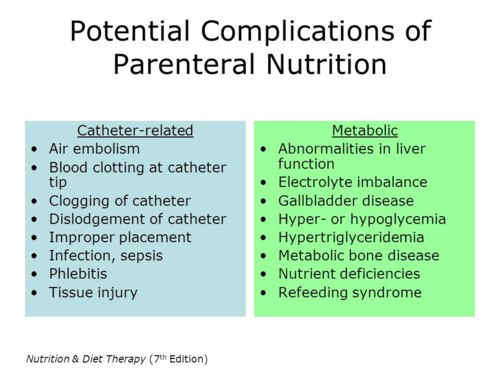While caring for a client receiving total parenteral nutrition (TPN), it is most important for the nurse to monitor which of the client's lab values?
Urinary ketones.
Serum protein.
Serum osmolarity.
Capillary glucose.
The Correct Answer is D
Correct answer: D
Choice A
Urinary ketones are not most important. Monitoring urinary ketones can provide information about the utilization of glucose and fat as energy sources. However, it is not the primary lab value to monitor in TPN administration.
Choice B
Serum protein is not most important. Monitoring serum protein levels is important to assess nutritional status, but it might not be as immediate a concern as serum osmolarity.
Choice C
Serum osmolarity reflects the concentration of particles (such as electrolytes, glucose, and other solutes) in the blood. Monitoring serum osmolarity is important to prevent complications related to fluid and electrolyte imbalances that can arise from the administration of TPN. Blood glucose levels (option D) are more critical because TPN can significantly impact glucose metabolism
Choice D
When caring for a client receiving total parenteral nutrition (TPN), the nurse’s priority is to monitor blood glucose levels. TPN can affect blood glucose, and observing for signs of hyperglycemia or hypoglycemia is crucial. Additionally, administering insulin as directed based on blood glucose levels is essential.

Nursing Test Bank
Naxlex Comprehensive Predictor Exams
Related Questions
Correct Answer is B
Explanation
Choice A
Potatoes are incorrect. Potatoes are high in carbohydrates and can cause a rapid increase in blood sugar levels, so they are not the best choice for someone with diabetes trying to avoid refined sugars and carbs.
Choice B
Avocado is correct. Avocado is a good choice for someone with Type 2 diabetes who wants to avoid refined sugars and carbohydrates. Avocado is a healthy source of monounsaturated fats, fibre, and various vitamins and minerals. It has a low glycaemic index and doesn't significantly raise blood sugar levels, making it a suitable option for people with diabetes.
Choice C
Grapes is incorrect: Grapes are a fruit with natural sugars, and although they contain fibre, they can still cause spikes in blood sugar levels.
Choice D
Pretzels are incorrect. Pretzels are usually made from refined flour and are high in simple carbohydrates, causing rapid spikes in blood sugar levels. They are not a good choice for someone with diabetes aiming to avoid refined sugars and carbs.
Correct Answer is A
Explanation
Choice A
High protein should be encouraged. The small reddened area on the coccyx is concerning for a potential pressure ulcer (also known as a pressure sore or bed sore). Pressure ulcers can occur when there is prolonged pressure on a specific area of the skin, often in individuals who are bedridden or have limited mobility. Adequate nutrition, including a high protein diet, is essential for preventing and promoting the healing of pressure ulcers. Protein is crucial for tissue repair and wound healing. A diet high in protein can aid in the recovery of damaged skin and promote the healing process. It helps to maintain and rebuild skin tissue, which is particularly important when dealing with potential pressure ulcers.
Choice B
High roughage should not be encouraged. While dietary fibre (roughage) is important for overall bowel health and regularity, it may not have a direct impact on wound healing in this context.
Choice C
Low cholesterol should not be encouraged. A low cholesterol diet is typically recommended to manage cardiovascular health and reduce the risk of heart disease. While overall health is important, cholesterol levels may not have a direct impact on wound healing in this case.
Choice D
Low salt should not be encouraged. A low salt diet is often recommended for individuals with certain medical conditions, such as hypertension or heart failure. While maintaining a balanced diet is important, salt intake may not be the primary concern when addressing wound healing.
Whether you are a student looking to ace your exams or a practicing nurse seeking to enhance your expertise , our nursing education contents will empower you with the confidence and competence to make a difference in the lives of patients and become a respected leader in the healthcare field.
Visit Naxlex, invest in your future and unlock endless possibilities with our unparalleled nursing education contents today
Report Wrong Answer on the Current Question
Do you disagree with the answer? If yes, what is your expected answer? Explain.
Kindly be descriptive with the issue you are facing.
